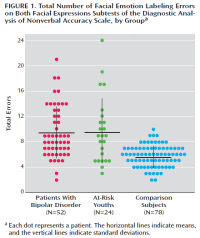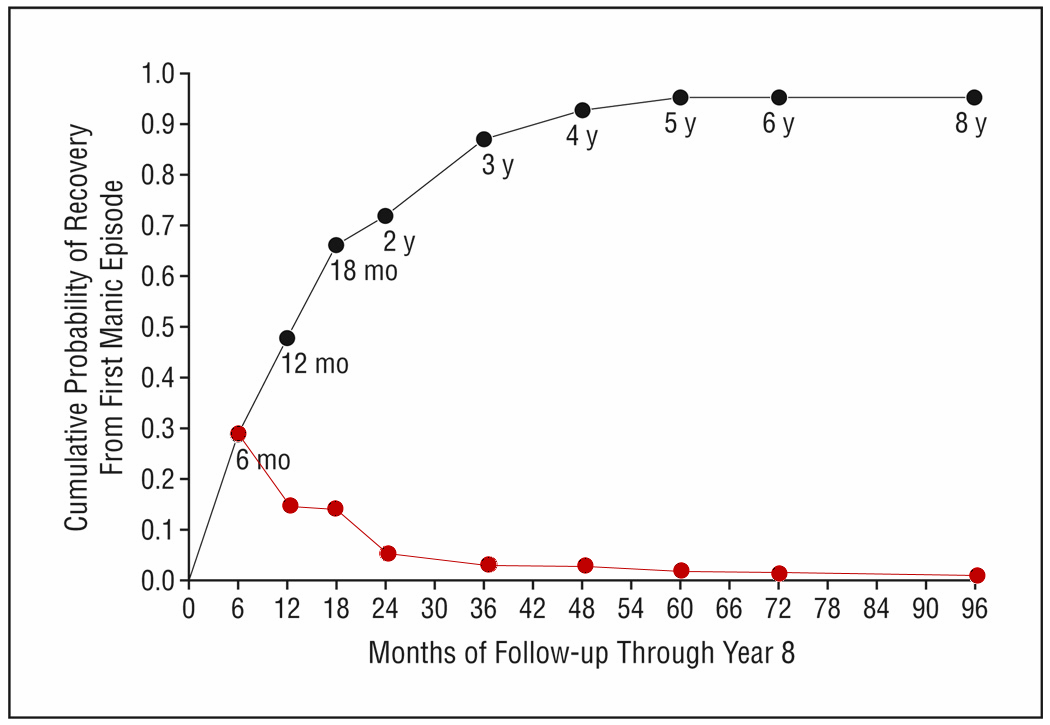Severe mood dysregulation, irritability, and the diagnostic boundaries of bipolar disorder in youths
by Leibenluft E.
American Journal of Psychiatry. 2011 168(2):129-42.
AbstractIn recent years, increasing numbers of children have been diagnosed with bipolar disorder. In some cases, children with unstable mood clearly meet current diagnostic criteria for bipolar disorder, and in others, the diagnosis is unclear. Severe mood dysregulation is a syndrome defined to capture the symptomatology of children whose diagnostic status with respect to bipolar disorder is uncertain, that is, those who have severe, nonepisodic irritability and the hyperarousal symptoms characteristic of mania but who lack the well-demarcated periods of elevated or irritable mood characteristic of bipolar disorder. Levels of impairment are comparable between youths with bipolar disorder and those with severe mood dysregulation. An emerging literature compares children with severe mood dysregulation and those with bipolar disorder in longitudinal course, family history, and pathophysiology. Longitudinal data in both clinical and community samples indicate that nonepisodic irritability in youths is common and is associated with an elevated risk for anxiety and unipolar depressive disorders, but not bipolar disorder, in adulthood. Data also suggest that youths with severe mood dysregulation have lower familial rates of bipolar disorder than do those with bipolar disorder. While youths in both patient groups have deficits in face emotion labeling and experience more frustration than do normally developing children, the brain mechanisms mediating these pathophysiologic abnormalities appear to differ between the two patient groups. No specific treatment for severe mood dysregulation currently exists, but verification of its identity as a syndrome distinct from bipolar disorder by further research should include treatment trials.
ECNP consensus meeting. Bipolar depression. Nice, March 2007
by Goodwin GM, Anderson I, Arango C, Bowden CL, Henry C, Mitchell PB, Nolen WA, and Vieta E, Wittchen HU
European Neuropsychopharmacoly 2008 18(7):535-49.
Abstract…Bipolar I disorder is rare in prepubertal children, when defined according to unmodified DSM-IV-TR criteria. A broad diagnosis of bipolar disorder risks confounding with other childhood psychopathology and has less predictive value for bipolar disorder in adulthood than the conservative definition. Nevertheless, empirical studies of drug and other treatments and longitudinal studies to assess validity of the broadly defined phenotype in children and adolescents are desirable, rather than extrapolation from adult bipolar practice. The need for an increased capacity to conduct reliable trials in children and adolescents is a challenge to Europe, whose healthcare system should allow greater participation and collaboration than other regions, via clinical networks. ECNP will aspire to facilitate such developments…
Child Bipolar I Disorder [full text]
Prospective Continuity With Adult Bipolar I Disorder; Characteristics of Second and Third Episodes; Predictors of 8-Year Outcome
by Barbara Geller, MD; Rebecca Tillman, MS; Kristine Bolhofner, BS; and Betsy Zimerman, MA
Arch Gen Psychiatry. 2008 65(10):1125-1133.
Abstract
Context: Child bipolar I disorder (BP-I) is a contentious diagnosis.
Objective: To investigate continuity of child and adult BP-I and characteristics of later episodes.
Design: Inception cohort longitudinal study. Prospective,blinded, controlled, consecutive new case ascertainment.
Setting: University medical school research unit.
Subjects: There were 115 children, enrolled from 1995 through1998, aged 11.1 (SD, 2.6) years with first episode DSM-IV BP-I, mixed or manic phase, with 1 or both cardinal symptoms (elation or grandiosity) and score of 60 or less on the Children’s Global Assessment Scale (CGAS). All DSM-IV severity and duration criteria were fulfilled. Separate interviews were conducted of parents about their children and of children about themselves.
Main Outcome Measures: Washington University in St Louis Kiddie Schedule for Affective Disorders and Schizophrenia (WASH-U-KSADS); Psychosocial Schedule for School Age Children–Revised; CGAS.
Results: Retention was 93.9% (n = 108) for completing assessments at every one of the 9 follow-up visits. Subjects spent 60.2% of weeks with any mood episodes and 39.6% of weeks with mania episodes, during 8-year follow-up. During follow-up,87.8% recovered from mania, but 73.3% relapsed to mania. Even accounting for family psychopathology, low maternal warmth predicted relapse to mania, and more weeks ill with manic episodes was predicted by low maternal warmth and younger baseline age. Largely similar to first episodes, second and third episodes of mania were characterized by psychosis, daily (ultradian) cycling,and long duration (55.2 and 40.0 weeks, respectively), but significantly shorter than first episodes. At 8-year follow-up, 54 subjects were 18.0 years or older. Among subjects 18.0 years or older,44.4% had manic episodes and 35.2% had substance use disorders.
Conclusions: In grown-up subjects with child BP-I, the44.4% frequency of manic episodes was 13 to 44 times higher than population prevalences, strongly supporting continuity.The rate of substance use disorders in grown-up child BP-I was similar to that in adult BP-I.
In case you haven’t figured it out, this post isn’t about childhood bipolar disorder, it’s about how to look at modern psychiatric literature. Thirty years ago, it never would’ve occurred to me to look first at who funded the study, then at the conflict of interest declarations, then who did the study or gave the opinion. But that’s the name of the game now. And, as we’ve seen with the Biederman story, or the Keller story, or the Nemeroff story, the old hallowed halls don’t count anymore – Harvard, Brown, Emory.
 There are other things. This is from one of Dr. Leiberluft’s papers. Notice that she shows the raw data along with the mean and standard deviation. She’s not hiding behind massaged data. That’s a plus. Considering the number of dolled up graphs that hide rather than reveal the actual data, it’s a breath of fresh air to see one point for each subject. It makes the data look a lot more messy, but that’s the way science is – messy [click on the figure to see the whole study]. And when data is shown as a frequency as below from Geller’s study, it ought to make intuitive sense. The overwhelming majority of the cases had periodic illness [recovered] – the hallmark of bipolar disorder. Compare this graph to the Bipolar NOS data in the COBY study where many of the subjects obviously had a chronic problem – unlike bipolar illness.
There are other things. This is from one of Dr. Leiberluft’s papers. Notice that she shows the raw data along with the mean and standard deviation. She’s not hiding behind massaged data. That’s a plus. Considering the number of dolled up graphs that hide rather than reveal the actual data, it’s a breath of fresh air to see one point for each subject. It makes the data look a lot more messy, but that’s the way science is – messy [click on the figure to see the whole study]. And when data is shown as a frequency as below from Geller’s study, it ought to make intuitive sense. The overwhelming majority of the cases had periodic illness [recovered] – the hallmark of bipolar disorder. Compare this graph to the Bipolar NOS data in the COBY study where many of the subjects obviously had a chronic problem – unlike bipolar illness.
[1st derivative added = approximate duration of episodes]
I like the authors you discuss today, and have read some of their other work but … the papers above all cover Bipolar I, when most early-onset Bipolar tends to fall into BPII/NOS categories (at least according to my reading).
“There is no urgency in trying out new psychiatric medications”
For the vast majority of people of any age with Bipolar, the medications available are not that great. (Again, from what I’ve read) we’ve got some good tools for mania but not so much for Bipolar depression.
I like to see academia and the pharma companies working together, because to me that has more real world applications. And the ECNP does work with pharma companies — and they recommend brand-name drugs in their treatment guidelines for Bipolar — although the financial arrangements are likely different when you’re talking about national health systems. But pharma money is still there.
Hey I am no researcher but don’t you think this study should have had another psychiatric group (other than bipolar disorder) as a control group? How else would one conclude that these “facial emotion identifying errors” are specific to bipolar????Maybe all psychiatric patients have errors in this proficiency. Just asking.
Tom,
I’m not either [a researcher], but you make a good point. I’m so hungry for honesty these days that I’m a sucker for ‘one dot per patient.’ The kind of question you’re raising is exactly the kind of thing we should be talking about – rather than looking in all the corners for signs of fraud. Thanks for the comment…